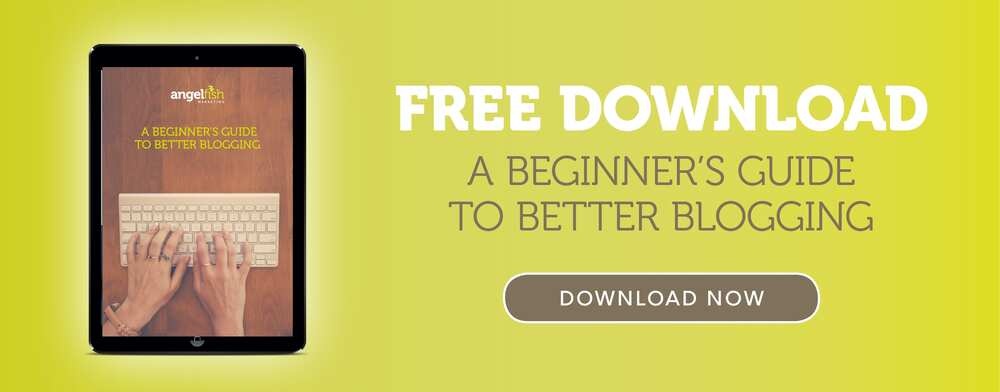Did you know that content marketing costs 62% less than outbound marketing yet produces three times as many leads1? When you put it like that, it makes sense to get your content marketing right so you can appeal to your audience, engage with your prospects and ultimately see those leads increase - and blogging is a great place to start.
Not only is a regular blog one of the best ways to fill your website with fresh content (which Google loves) but it’s also a great way to position your site as a relevant and important answer to your customers’ questions. But where do you start? Read on for our seven steps for getting started with blogging…
.jpg?width=848&height=566&name=blogging-2%20(1).jpg)
- Pinpoint your personas
First things first you need to know who you’re writing for and why. There’s currently way too much ‘me, me, me’ content out there, with businesses just writing about themselves with no regard for their customers - which is exactly why you should kick things off by identifying your buyer personas. A buyer persona is a fictional character that portrays the needs, goals, pain points and challenges of your potential customers - and by identifying these challenges you can start to create content that provides solutions. It’s basically about identifying any difficulties they have and letting them know how you can help resolve it. Find out more here.
- Create a content calendar
Once you’ve identified your personas, successful blogging relies on regularly producing informative and engaging content that appeals to them. There’s no point in bashing content out willy nilly - in order to get the results you are looking for, you need to have a plan. Content mapping is the process of planning your content around your buyer personas and identifying topics that can help then solve their pain points. Not only does this mean you can be completely confident that your blogs are providing real value, but it’s also much easier to get in the habit of creating and publishing regular content if you have a clear calendar to stick to.
- Make sure it’s SEO optimised
If you really want to stand out against your competitors you need to make sure your readers can find you - which is where SEO comes in. It’s not just about stuffing as many keywords as possible into your posts anymore - in fact that can actually have a detrimental effect on your rankings that will put off both Google and your readers. A good rule of thumb is to focus on one or two long-tail keywords per blog post - and don’t forget to include inbound and internal links to show search engines that your content is relevant too. Check out this blog for more tips on SEO optimisation.
- Use the topic cluster model
A topic cluster model is a great way to organise your content and boost your SEO. It works by having one large piece of pillar content which broadly outlines a chosen topic and is surrounded by a group of cluster content that focuses on specific long-tail keywords. The pillar page links to each cluster page, whilst the cluster pages all link back to the pillar page with the same hyperlinked keyword so that all the content works together - which means when one page performs well, the entire topic cluster gets a boost. It’s all about signalling to Google that there’s a semantic relationship between your content and that you're a trusted authority on the topic - which can really help to boost your rankings and get your blog seen. Not only that, but topic clusters can also help you decide on your content strategy, too. Find out more here.
- Get into your groove
The number one way to stand out from the crowd when writing a blog is to just be yourself. Try writing as if you are speaking directly to your readers: by writing in the first person and telling a story, you can identify your tone of voice and reveal the personality behind your brand, which in turn keeps your readers engaged and makes your brand feel more approachable. And above all, remember that just because you’re writing about business, it doesn’t mean it needs to be boring! Engaging with your customers through well written content is one of the best ways to connect with your audience and keep them coming back for more, so have fun with it - if you enjoy writing it, chances are they’ll probably enjoy reading it, too.
- Make sure it looks good
As well as ensuring your blog delivers valuable information in an interesting and engaging way, you also need to make sure it looks good. It goes without saying that what you’re writing about is the most important thing - but people have got to look at your blog and want to read it. That means your blog should be easy to read and visually attractive in order to draw people in: use short sentences, paragraphs, headings and bullet points to break up your content into nice bitesize pieces with lots of white space so it looks more inviting. And where possible, use visuals too - from relevant images to videos or even infographics, different visual elements will also help you to appeal to your users.
- Steer clear of jargon
It’s really easy to include too much jargon in your blog without realising - especially if you are writing about something very specific to your industry. However your readers most likely won’t want to read a blog that’s jam-packed full of jargon, so where possible it’s best to keep the industry lingo to a minimum. After all, you want your readers to understand everything you are saying without having to Google every other word. Saying that, if you really do need to include some jargon, just make sure you link out to a definition to help them out.
So there you have it! Seven simple steps for blogging success. And just one more really important bonus tip - be patient. We know we keep saying this about inbound and content marketing, but Rome really wasn’t built in a day. Blogging takes time to grow, so you’ll need to be patient and persistent. Stick to your calendar and continue to publish and share valuable content and you will see your leads and website hits grow - promise! For more top tips and advice on content marketing, download our guide to blogging.
Sources:




.png?width=500&name=A%20group%20of%20people%20talking%2c%20taking%20part%20in%20market%20research.%20(3).png)





